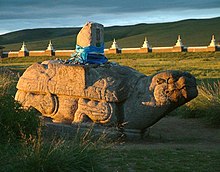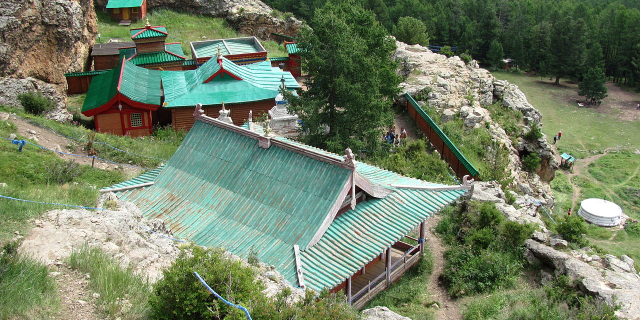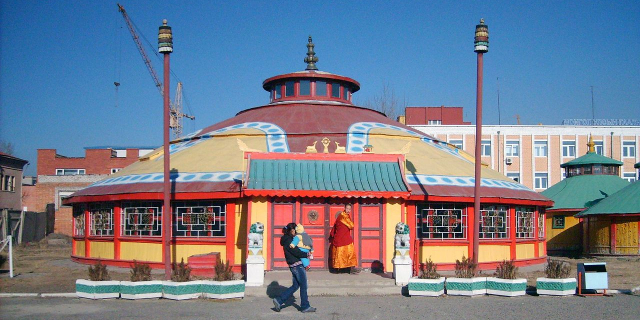Karakorum
Karakorum (Khalkha Mongolian: Хархорум, Kharkhorum; Mongolian script:ᠬᠠᠷᠠᠬᠣᠷᠣᠮ, Qaraqorum; Chinese: 哈拉和林) was the capital of the Mongol Empire between 1235 and 1260 and of the Northern Yuan dynasty in the 14–15th centuries. Its ruins lie in the northwestern corner of the Övörkhangai Province of modern-day Mongolia, near the present town of Kharkhorin and adjacent to the Erdene Zuu Monastery, which is likely the oldest surviving Buddhist monastery in Mongolia. They are in the upper part of the World Heritage Site Orkhon Valley.
 13th-century stone turtle (bixi)
13th-century stone turtle (bixi) The Silver Tree of Karakorum. 18th-century Dutch imagination.
The Silver Tree of Karakorum. 18th-century Dutch imagination. Green glazed roof tile from a 64-pillar 13th-century palace
Green glazed roof tile from a 64-pillar 13th-century palace 13th-century brick-producing kiln in Karakorum
13th-century brick-producing kiln in KarakorumThe Orkhon valley was a center of the Xiongnu, Göktürk, and Uyghur empires. To the Göktürks, the nearby Khangai Mountains had been the location of the Ötüken (the locus of power), and the Uyghur capital Karabalgasun was located close to where later Karakorum would be erected (downstream the Orkhon River 27 km north–west from Karakorum). This area is probably also one of the oldest farming areas in Mongolia.[1]
In 1218–1219, Genghis Khan rallied his troops for the campaign against the Khwarazmian Empire in a place called Karakorum,[2] but the actual foundation of a city is usually said to have occurred only in 1220. Until 1235, Karakorum seems to have been little more than a yurt town; only then, after the defeat of the Jin empire, did Genghis' successor Ögedei erect city walls and build a fixed palace.[3]
Ögedei Khan gave the decree to build the Tumen Amgalan Ord (Palace of Myriad Peace; Wan'angong in Chinese) in 1235 the year after he defeated the Jin dynasty. It was finished in one year. In the History of Yuan (元史), it is written in the section for Taizong (太宗) Ögedei Khan: "In the seventh year (1236), in the year of the blue sheep the Wan'angong (萬安宮) was established in Helin (和林, Karakorum)." One of Genghis Khan's nine ministers, Yelü Chucai (1190–1244), said the following poem during the ridge raising ceremony of the Tumen Amgalan Ord: "Installed ridge well fit and stone foundation, The parallel placed majestic palace has been raised, When the bells and drums of the Lord and officials sound pleasantly, The setting sun calls the horses of war to itself from the mountain peaks." The Mongolian version of the poem is as follows: "Tsogtslon tavih nuruu chuluun tulguur, Zeregtsen zogsoh surleg asriig bosgovoi, Ezen tushmediin honh hengereg ayataihan hanginan duursahad, Echih naran uuliin tolgoigoos dainii agtadiig ugtnam.[4][5]
ProsperityUnder Ögedei and his successors, Karakorum became a major site for world politics. Möngke Khan had the palace enlarged, and the great stupa temple completed.[3] They had the enslaved Parisian goldsmith Guillaume Bouchier[6][7][8] design the Silver Tree of Karakorum for the city center.[9] A large tree sculpted of silver and other precious metals rose up from the middle of the courtyard and loomed over the palace, with the branches of the tree extending into the building. Silver fruit hung from the limbs and it had four golden serpents braided around the trunk, while within the top of the tree was placed a trumpet angel, all as automata performing for the emperor's pleasure. When the khan wanted to summon the drinks for his guests, the mechanical angel raised the trumpet to his lips and sounded the horn, whereupon the mouths of the serpents began to gush out a fountain of alcoholic beverages into the large silver basin arranged at the base of the tree.[10]
William of RubruckWilliam of Rubruck, a Flemish Franciscan missionary and papal envoy to the Mongol Empire reached Karakorum in 1254. He left one of the most detailed, though not always flattering, accounts of the city. He compared it rather unfavorably to the village of Saint-Denis near Paris, and was of the opinion that the royal abbey there was ten times as magnificent as the Khan's palace.[11] On the other hand, he also described the town as a very cosmopolitan and religiously tolerant place, and the silver tree he described as part of Möngke Khan's palace as having become the symbol of Karakorum.[12][13] He described the walled city as having four gates facing the four directions, two quarters of fixed houses, one for the "Saracenes" and one for the "Cathai", twelve pagan temples, two mosques, as well as a Nestorian church.[3][14]
Later timesWhen Kublai Khan claimed the throne of the Mongol Empire in 1260—as did his younger brother, Ariq Böke—he relocated his capital to Shangdu, and later to Khanbaliq (Dadu, today's Beijing). Karakorum was thence reduced to a mere administrative center of a provincial backwater of the Yuan dynasty of China in 1271. Furthermore, the ensuing Toluid Civil War with Ariq Böke and a later war with Kaidu deeply affected the town. In 1260, Kublai disrupted the town's grain supply, while in 1277 Kaidu took Karakorum, only to be ousted by Yuan troops and Bayan of the Baarin in the following year.[15] In 1298–99 prince Ulus Buqa looted its markets and the grain storehouses. However, the first half of the 14th century proved to be a second era of prosperity: in 1299, the town had been expanded eastwards, then in 1311, and again from 1342 to 1346, the stupa temples were renewed.[3]
Decline Old, damaged stupa of Nirvana
Old, damaged stupa of NirvanaAfter the collapse of the Yuan dynasty in 1368, Karakorum became the residence of Biligtü Khan in 1370. In 1388, Ming troops occupied and later razed Karakorum. According to Saghang Sechen's Erdeni-yin Tobči, in 1415 a khuriltai decided to rebuild it, but no archaeological evidence for such a venture has been found yet. However, Karakorum was inhabited at the beginning of the 16th century, when Batu-Möngke Dayan Khan made it a capital once again. In the following years, the town changed hands between Oirads and Chinggisids several times, and was consequently given up permanently.[clarification needed][3]































Add new comment